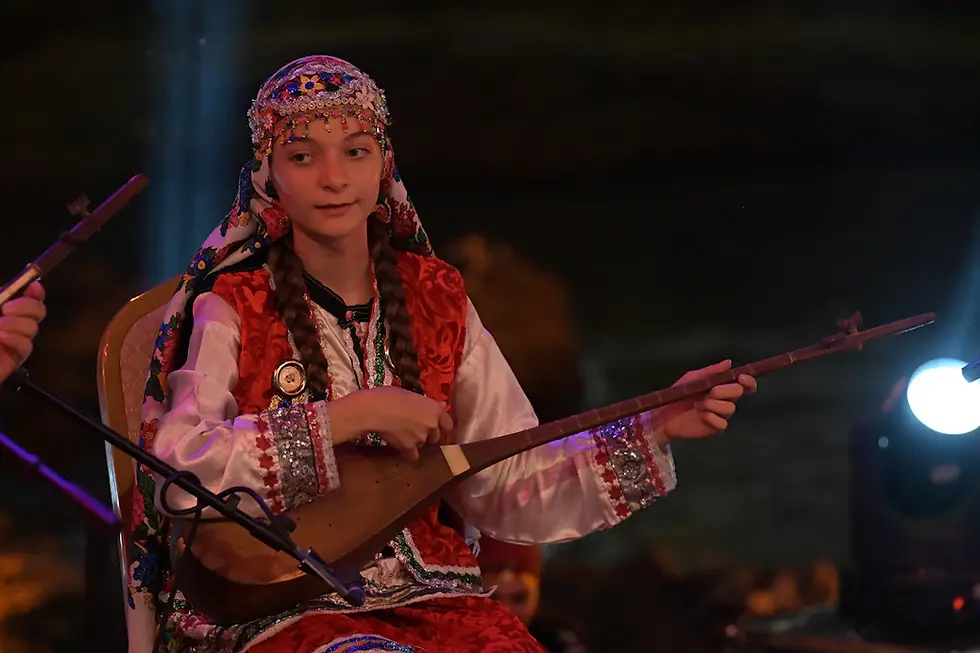Exploring the Melodies of Time: Kurdish Music and Its Historical Context
- Removals Eastbourne
- 24 hours ago
- 6 min read

Overview
Kurdish music is a profound reflection of Kurdish history and culture, serving as a narrative of identity, struggle, and community. It blends traditional and modern influences, preserving cultural heritage while evolving globally. Key themes include love, resistance, and cultural pride, with musicians acting as cultural bearers. Despite challenges to its preservation, Kurdish music continues to thrive and inspire, fostering appreciation and understanding of Kurdish culture worldwide.
Contents
Kurdish music, rich in tradition and emotional depth, serves as a powerful reflection of kurdish history and culture. With roots that intertwine deeply with the vibrant kurdistan culture and heritage, Kurdish music is not just an art form but a narrative of the Kurdish people themselves. This blog post will explore the significance of Kurdish music within its historical context, shedding light on how it has shaped not only the identity of the Kurds but also their interaction with the evolving landscapes of historical movements and diplomacy.
The Essence of Kurdish Music
Kurdish music encapsulates a variety of genres, instruments, and influences. At its core, it conveys the stories and emotions of the Kurdish people. Traditional instruments such as thetanbur,duduk, anddafplay a vital role in the creation of music that resonates with the themes of love, struggle, and beauty inherent in Kurdish life.
Throughout history, Kurdish music has served many purposes: as a method of storytelling, a means to preserve cultural traditions, and a way to foster community spirit. However, to understand the music, we must first delve into the historical context from which it emerged.
Kurdish Historical Background
The Kurdish people are an ancient ethnic group with a shared identity that spans across the mountainous regions of Turkey, Iran, Iraq, and Syria. Their land, historically known as Kurdistan, has experienced significant socio-political changes through the ages. These changes have significantly influenced Kurdish music and its evolution.
From the days of early nomadic tribes to modern nation-states, the complexities of kurdish historical movements and diplomacy have shaped the fabric of Kurdish society. The impacts of foreign rule, colonialism, and regional conflicts have provoked a dynamic interaction between the music of the Kurds and the socio-political circumstances they face.
The Role of Music in Kurdish Identity
Kurdish music often serves as a medium for preserving language, cultural traditions, and communal narratives, especially during periods of national repression. Many Kurdish public figures have utilized music as a form of resistance against suppression, using songs as tools for both political awareness and solidarity.
Musicians as Cultural Bearers
Kurdish musicians often find themselves in the role of cultural bearers—individuals who pass down traditions and memories through their craft. Influential Kurdish historical figures in music, such asŞivan PerwerandAhmad Khani, have become icons not only for their musical achievements but also for their commitment to the Kurdish cause. Their work transcends mere entertainment; they provide a glimpse into the struggles and joys of Kurdish existence, creating an enduring legacy for future generations.
Thematic Influences in Kurdish Music
Different themes permeate Kurdish music, often echoing the collective memory of the Kurdish people. Here are some common themes:
Love and Relationships: Many songs explore romantic longing and the complexities of love, reflecting the deep emotional ties shared among families and communities.
Struggle and Resistance: Given the tumultuous history of the Kurds, songs often narrate stories of hardships, victories, and aspirations for freedom, enabling listeners to connect deeply with their heritage.
Cultural Pride: Celebrating Kurdish culture, traditional songs often exalt the beauty of the land and the strength of the people.
Traditional vs. Modern Influences
The landscape of Kurdish music is continuously evolving, with a blend of traditional and modern influences. Traditional music often features folk styles and lyrics passed down through generations, whereas contemporary Kurdish music may incorporate various genres, including pop and rock. This fusion of styles allows newer generations to connect with their roots while also appealing to a broader audience.
Musicians today often draw inspiration from the past while innovating and pushing the boundaries of the genre. Contemporary artists likeHozan BîndarandÇiğdem Aslanblend traditional sounds with modern instrumentation, creating a rich, accessible format that resonates with both younger and older audiences alike.
The Global Reach of Kurdish Music
Kurdish music has transcended borders, gaining international recognition for its unique qualities. Songs in Kurdish languages like Kurmanji and Sorani have spread beyond their original regions, leading to a growing appreciation for Kurdish culture globally.
Events like the annual Kurdish Culture Festival showcase Kurdish music and dance, attracting audiences worldwide. This exposure not only enriches global music but also fosters cross-cultural dialogues, helping to educate people about Kurdish history and struggles.
The Importance of Preservation
As modern civilization gifts countless changes, there rests the monumental importance of preserving traditional Kurdish music. Cultural preservationists and organizations play an essential role in documenting and promoting Kurdish musical heritage, ensuring that these sounds continue to echo in the future.
Modern Challenges
However, various challenges threaten the continuity of traditional music. Political turmoil and conflicts have, at times, hindered the performance and promotion of Kurdish music, especially in regions where cultural expression is strictly monitored. Efforts inspired by Kurdish public figures aim to advocate for the right to cultural expression, utilizing music as a vehicle for change.
Cultural Education Initiatives
Organizations and local communities are increasingly investing in cultural education initiatives to teach younger generations about their musical heritage. Workshops and festivals provide platforms where experts and enthusiasts can share their knowledge, ensuring that traditional instruments and songs remain alive.
Online Presence and the Future
The internet has opened new avenues for Kurdish musicians. Social media platforms and music streaming services have broadened the scope for artists to showcase their talents, engage with fans, and collaborate with artists around the world. This accessibility is vital in keeping Kurdish music relevant to younger audiences.
Podcasts, live streams, and online videos also serve to educate global listeners, sharing the intricacies of Kurdish instruments and the stories behind the music. As a result, Kurdish music's richness can reach people far removed from its geographic and cultural origins.
A Journey Through Sound
As we reflect on the rich tapestry of Kurdish music and its intertwined historical context, it becomes clear that this art form is a vital vessel through which Kurdish history is told and cherished. The melodies encapsulate triumphs, sorrows, and the shared narrative of a resilient people who have faced countless challenges throughout history.
Kurdish historical figures and public figures are instrumental in shaping the understanding and appreciation of this culture, making it crucial to recognize their contributions. As Kurdish music continues to adapt and thrive, it remains a testament to the enduring spirit of the Kurdish people, bridging the gap between the past and the present, and paving the way for future generations to embrace their history through sound.
In the end, embracing Kurdish music goes beyond merely listening; it invites us to engage with the stories of kurdish history, championing the cultural heritage that has enriched the world's musical landscape. May the echoes of Kurdish songs continue to inspire and resonate for generations to come!
FAQs
What is the significance of Kurdish music in relation to Kurdish history and culture?
Kurdish music serves as a powerful reflection of Kurdish history and culture, preserving traditions and sharing the stories and emotions of the Kurdish people.
What are some traditional instruments used in Kurdish music?
Traditional instruments include the tanbur, duduk, and daf, which play a vital role in conveying themes of love, struggle, and beauty in Kurdish life.
How has Kurdish music evolved over time?
Kurdish music has evolved by blending traditional styles with modern influences, incorporating genres like pop and rock while still maintaining a connection to its roots.
What challenges does traditional Kurdish music face today?
Traditional Kurdish music faces challenges such as political turmoil and conflicts that hinder cultural expression, alongside the need for preservation against modern influences.
What role do online platforms play in the future of Kurdish music?
Online platforms expand opportunities for Kurdish musicians to showcase their work globally, engage with fans, and educate listeners about Kurdish culture and music.




Comments